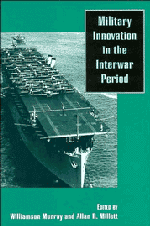Book contents
- Frontmatter
- Contents
- Acknowledgments
- Introduction
- 1 Armored warfare: The British, French, and German experiences
- 2 Assault from the sea: The development of amphibious warfare between the wars – the American, British, and Japanese experiences
- 3 Strategic bombing: The British, American, and German experiences
- 4 Close air support: The German, British, and American experiences, 1918–1941
- 5 Adopting the aircraft carrier: The British, American, and Japanese case studies
- 6 Innovation ignored: The submarine problem – Germany, Britain, and the United States, 1919–1939
- 7 From radio to radar: Interwar military adaptation to technological change in Germany, the United Kingdom, and the United States
- 8 Innovation: Past and future
- 9 Patterns of military innovation in the interwar period
- 10 Military innovation in peacetime
- Index
2 - Assault from the sea: The development of amphibious warfare between the wars – the American, British, and Japanese experiences
Published online by Cambridge University Press: 05 August 2012
- Frontmatter
- Contents
- Acknowledgments
- Introduction
- 1 Armored warfare: The British, French, and German experiences
- 2 Assault from the sea: The development of amphibious warfare between the wars – the American, British, and Japanese experiences
- 3 Strategic bombing: The British, American, and German experiences
- 4 Close air support: The German, British, and American experiences, 1918–1941
- 5 Adopting the aircraft carrier: The British, American, and Japanese case studies
- 6 Innovation ignored: The submarine problem – Germany, Britain, and the United States, 1919–1939
- 7 From radio to radar: Interwar military adaptation to technological change in Germany, the United Kingdom, and the United States
- 8 Innovation: Past and future
- 9 Patterns of military innovation in the interwar period
- 10 Military innovation in peacetime
- Index
Summary
On the morning of 12 November 1921, Charles Evans Hughes, Secretary of State of the United States, surveyed the thousand expectant spectators with a coolness matched only by the autumn winds. Hughes came to the podium of Continental Hall in Washington, D.C., to begin the International Conference on Limitation of Armament. Much to the surprise of the delegations and audience that crowded the hall, Hughes proposed a comprehensive plan to limit naval forces and to create a regime of non-aggression in Asia, the most potent remaining arena of international rivalry. By the time the delegates had completed their work in February 1922, they had cobbled together three major, interrelated treaties that shaped the naval policies of Britain, the United States, and japan through most of the interwar period.
One of the three major treaties – the Treaty for the Limitation of Armament – carried important implications for amphibious operations, a form of naval warfare not addressed in the negotiations. Although the conferees discussed the development of battleships, naval aviation, and submarines, they failed to discuss the ability of their navies to conduct assaults from the sea. Ironically, the japanese Army was the world's foremost amphibious force in 1921. Within twenty years Britain, the United States, and japan all identified a need for amphibious capability, but japan alone possessed the doctrine, tactical concepts, and forces for such operations in 1939.
- Type
- Chapter
- Information
- Military Innovation in the Interwar Period , pp. 50 - 95Publisher: Cambridge University PressPrint publication year: 1996
- 5
- Cited by

